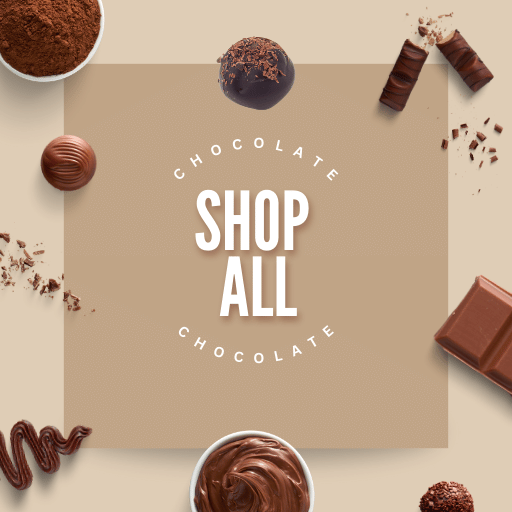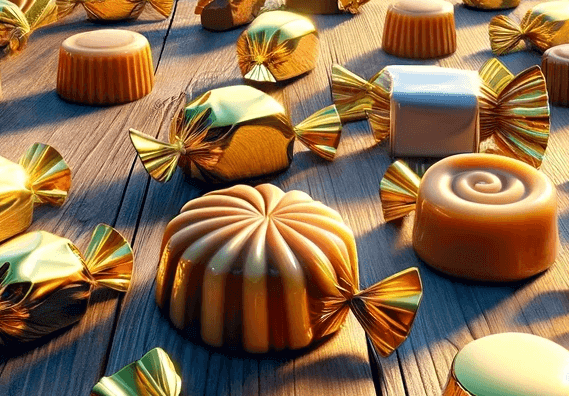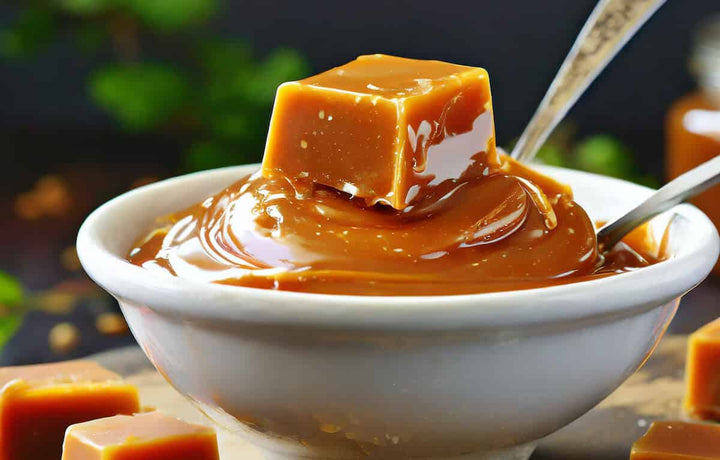Butterscotch, a classic confectionery delight, holds a special place in the hearts of sweet lovers worldwide.
In this post, we will explore the nuances of butterscotch's flavour profile, its traditional and modern culinary uses, and the secrets behind creating the perfect batch of this golden treat.
Whether drizzled over ice cream, stirred into warm puddings, or savoured as a standalone candy, butterscotch continues to captivate the taste buds of those who indulge in it.
What is Butterscotch?
Butterscotch is a type of confectionery whose primary ingredients are brown sugar and butter.
Often associated with rich, sweet flavours, butterscotch is a classic treat rooted in traditional English cuisine.
The defining characteristic of butterscotch is its use of brown sugar, which contains molasses.
This imparts a deeper, more complex sweetness than confections made with white sugar.
When combined and heated with butter, the sugar caramelises, producing butterscotch's distinctive flavour – a rich, creamy, and slightly toffee-like taste with a hint of saltiness.
In some recipes, other ingredients like cream, vanilla, and a pinch of salt are added to enhance the flavour and texture.
The cream adds richness and a smooth texture, while vanilla contributes to the depth of flavour.
Salt is used to balance the sweetness and bring out the other flavours.
Butterscotch is often used as a sauce, drizzled over desserts like ice cream, puddings, and cakes.
It can also be made into hard candies, soft chews, or other sweet treats like cookies and bars.

Related Post: What is Cinder Toffee?
What is Butterscotch Made Of?
Butterscotch is a confection that is primarily made from two key ingredients: brown sugar and butter.
The unique flavour of butterscotch, which sets it apart from similar confections like caramel, is largely due to the use of brown sugar.
Brown sugar contains molasses, which imparts a rich, deep sweetness with hints of toffee and a slight tang.
Here are the basic ingredients commonly used in making butterscotch:
-
Brown Sugar: The main ingredient, brown sugar, contributes to the confection's deep caramelised flavour and colour.
-
Butter: Adds creaminess and rich flavour, helping to create a smooth texture.
-
Cream: Often included to enhance the richness and create a smoother, more indulgent texture.
-
Vanilla Extract: Used for additional flavouring, vanilla complements the sweet, buttery taste of butterscotch.
-
Salt: A pinch of salt can be added to balance the sweetness and promote the other flavours more prominently.
The process of making butterscotch involves melting the butter and then mixing it with brown sugar.
This mixture is cooked over heat until the sugar dissolves and the ingredients combine to form a smooth mixture.
Cream, vanilla, and salt (if used) are then added, and the mixture is brought to a boil and simmered until it reaches the desired consistency.
Depending on the intended use, butterscotch can be cooked to varying stages.
The result is a rich, sweet, buttery confection versatile in its uses and beloved for its comforting flavour.
What Does Butterscotch Taste Like?
Butterscotch is renowned for its rich, indulgent flavour that is sweet and slightly salty.
The primary taste of butterscotch comes from its main ingredient, brown sugar, which imparts a deep, caramel-like sweetness.
This sweetness is characterised by notes of toffee and a hint of molasses, a complexity due to the molasses content in brown sugar.
Complementing the sweetness of the sugar is the butter, which adds a creamy, rich dimension.
This richness is often enhanced by adding cream, making the flavour profile of butterscotch even more luxurious and smooth.
The butter also brings a slight saltiness, which balances the overall sweetness and adds depth to the flavour.
Some recipes for butterscotch also include vanilla, which introduces a subtle aromatic sweetness, and a pinch of salt, which further accentuates the confection’s rich and complex taste.
The overall flavour of butterscotch can be described as a harmonious blend of sweet caramel and butter, with a hint of saltiness that rounds out the taste.

What is Butterscotch Sauce?
Butterscotch sauce is a sweet, rich condiment made from the core ingredients of butterscotch: brown sugar and butter.
It is a versatile sauce known for its smooth, creamy texture and deep, caramelised flavour that combines sweet and buttery notes with a hint of saltiness.
Making butterscotch sauce involves melting butter and then adding brown sugar.
Brown sugar is key to the sauce's distinctive flavour, as its molasses content imparts a rich, toffee-like sweetness.
Cream is usually added once the sugar and butter are combined and the sugar has dissolved.
This addition of cream enhances the sauce's richness and contributes to its smooth, velvety texture.
Often, a pinch of salt is included in the recipe to balance the sweetness and bring out the full range of flavours.
Vanilla extract is also a common ingredient, adding a layer of aromatic sweetness that complements the buttery caramel taste.
Butterscotch sauce is typically cooked until it thickens to a pourable consistency, perfect for drizzling.
It is a popular dessert topping for ice cream, pancakes, waffles, and puddings.
What is the Difference Between Butterscotch And Caramel?
The difference between butterscotch and caramel lies primarily in the ingredients used and the resulting flavour profiles, although they are similar in many ways.
Butterscotch is made using brown sugar and butter as its primary ingredients.
The brown sugar contains molasses and imparts a rich, deep sweetness with toffee notes.
Butter adds a creamy, rich flavour; often, butterscotch recipes include cream and vanilla for added richness and depth.
The result is a distinctly sweet flavour with a deep, buttery richness, often with a hint of saltiness due to the use of salted butter or adding a pinch of salt.
Caramel, on the other hand, is typically made from white sugar, water, and butter, with cream added later in the cooking process.
The white sugar is caramelised by heating, which gives caramel its characteristic golden-brown colour and rich, sweet flavour.
The absence of molasses in white sugar results in a flavour profile that is more singularly sweet and less complex than butterscotch.
The addition of butter and cream gives caramel a creamy, rich texture.
Where Does Butterscotch Come From?
Butterscotch is believed to have originated in England, with its history dating back to the mid-19th century.
The exact origin of butterscotch is somewhat unclear, but it is widely thought to have first been made in Yorkshire, a county in Northern England.
The term "butterscotch" itself was first recorded in 1817 in the Doncaster Gazette, a newspaper in Yorkshire, suggesting the confection was already well-known by that time.
The name "butterscotch" derives from the process of "scotching," which means to cut or score, a reference to the practice of scoring the confection into pieces before it hardens.
Another theory suggests the "scotch" part of the name could be linked to "scorch," referring to the cooking process of the sugar.
Butterscotch gained popularity for its rich, sweet, buttery flavour, becoming a staple in British confectionery.
It was enjoyed as a candy and used as a flavour for puddings, sauces, and other desserts.
The popularity of butterscotch spread from the UK to other parts of the world, where it has been embraced and adapted into various culinary traditions.
Why is it Called Butterscotch?
The term "butterscotch" is thought to originate from the confection's primary ingredients – butter and the process of "scotching," which in this context means to cut or score.
The "butter" part of the name straightforwardly refers to one of the key components of the sweet.
Butterscotch is made with a significant amount of butter, which gives it its rich, creamy texture and flavour.
The "scotch" part is less clear but is generally believed to refer to the process of "scotching," or cutting, the sugar and butter mixture before it hardens completely.
In the early days of butterscotch production, the confection would be poured into a tray to cool and then "scotched" or scored into squares or rectangles while still warm and pliable, making it easier to break into pieces once fully hardened.
Another theory, though less commonly cited, suggests that "scotch" could be derived from the word "scorch," relating to the cooking process of the sugar.
This interpretation aligns with the method of caramelising sugar, a key step in making butterscotch.
Regardless of the exact origin of its name, butterscotch has become synonymous with the delicious combination of butter and brown sugar, cooked to a specific consistency and loved for its rich, sweet flavour.
Where Can You Buy Tasty Chocolate?
Whitakers Chocolates, renowned for our long history in crafting delicious and affordable chocolates, offers a range of options suitable for everyone, including vegetarian, vegan, and gluten-free choices.
Our top-selling products, such as indulgent Coffee Creams, Neapolitans, Chocolate Wafer Thins, Stem Ginger and Luxury Chocolate Truffles, are perfect for enhancing your mocha coffee experience.
Click here to see our full range of delicious chocolates…
Some Notes From an Expert Chocolatier
One of the most fulfilling aspects of my craft is the fusion of chocolate with various other confectionery ingredients.
This creative blending enhances flavours and introduces an array of textures, making each chocolate creation a unique experience.
One confection I particularly enjoy working with is butterscotch.
Its rich, buttery sweetness, with a hint of saltiness, complements chocolate exceptionally well.
When butterscotch is combined with chocolate, it creates a delightful contrast – the smoothness of the chocolate pairs beautifully with the deep, caramelised notes of the butterscotch.
Whether incorporating butterscotch pieces into chocolate bars or using butterscotch sauce as a filling for truffles, the combination always results in a luxurious treat.
Final Notes On Butterscotch
Butterscotch is a classic confection that has stood the test of time, enchanting palates with its rich, buttery sweetness and hint of saltiness.
Originating from the simple combination of brown sugar and butter and often enhanced with cream and vanilla, butterscotch has a distinct flavour profile that sets it apart from similar treats like caramel and toffee.
Its deep, caramelised sweetness, imparted by the molasses in the brown sugar, and the creamy richness from butter make it a versatile and beloved ingredient in various desserts and confections.
Butterscotch’s enduring popularity lies in its comforting taste and the nostalgia it evokes, reminding many of traditional sweets and childhood treats.
Whether used as a sauce, a filling, or a standalone candy, butterscotch adds a touch of indulgence and warmth to any dessert.











